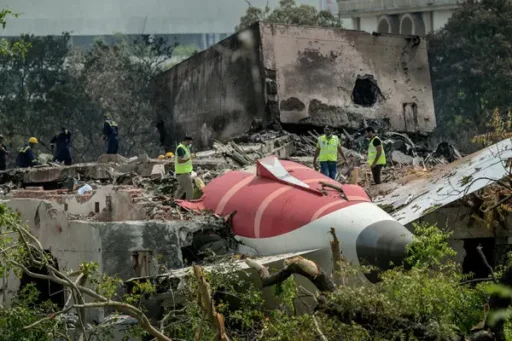
Horrific Crash Rattles Aviation Safety Landscape
On June 12, 2025 at 1:38 PM IST, Air India Flight AI171, a Boeing 787‑8 Dreamliner bound for London Gatwick, tragically crashed just seconds after takeoff from Ahmedabad’s Sardar Vallabhbhai Patel International Airport. Horrific visuals showed the aircraft struggling to gain altitude—landing gear extended, wings low—before plummeting into the campus of B.J. Medical College hostel. The crash claimed 241 lives on board, plus 19 fatalities on the ground, while only one passenger survived, later identified as Viswash Kumar Ramesh.
Immediate Aftermath and Emergency Response
Firefighters and medical teams rushed to the scene amid thick smoke and debris strewn across the college compound. Hospitals in Ahmedabad, along with national air-crash squads, worked round-the-clock. DNA labs were activated to identify charred remains. By June 19, most wreckage remained at the crash site as investigation agencies sifted through debris.
The public reacted with grief and anger. Prime Minister Narendra Modi called the tragedy “heartbreaking beyond words” and personally monitored relief operations. Local volunteers and students assisted in evacuation and post-crash aid at the medical college.
Preliminary Investigations Spotlight Fuel Cut-Off Switch
In mid-July, the Aircraft Accident Investigation Bureau (AAIB) issued a preliminary report: both engine fuel control switches had been flipped to the “CUTOFF” position within one second of liftoff, triggering dual engine thrust loss. The engines did not regain power in time, and the aircraft crashed. Video evidence showed the Ram Air Turbine (RAT) deployment—activated only when engine power fails—confirming total thrust loss.
Though both pilots were experienced, cockpit voice recordings revealed confusion: one pilot questioned why the switches were off, and the other denied responsibility. The preliminary report did not conclusively assign blame to either pilot, and no mechanical fault was found in the Boeing fuel system. Aviation unions strongly criticised speculative conclusions and urged restraint until the final report.
Safety Lapses and Regulatory Oversight Failures
In parallel, DGCA documents revealed that the same aircraft had been grounded in December 2024 for technical faults but later returned to service. Show cause notices issued in June questioned maintenance lapses, expired safety equipment, and outdated emergency slides. Internal audits uncovered 51 systemic safety violations across Air India operations, including squad staffing shortages and training gaps in simulators for Boeing crew.
This regulatory backlog has sparked widespread concern over airline safety culture and enforcement mechanisms.
Corporate & Government Reactions
Air India CEO Campbell Wilson defended the crew, noting they passed all checks and training requirements. He emphasized that no systemic mechanical defect had been found in the Dreamliner fleet. Boeing and engine maker GE pledged full cooperation with investigators.
The Tata Group, owner of Air India, announced an immediate interim compensation of ₹25 lakh for the families of deceased passengers and 19 ground victims. A welfare trust was also established to support long-term relief efforts.
The DGCA ordered inspections of all 33 Boeing 787 Dreamliners, grounded dozens of flights for additional checks, and mandated airport emergency drills by June 30. Regulators and airlines stress no aircraft will ferry passengers until flaws are resolved.
Public Sentiment and Psychological Impact
The crash has sparked a wave of public fear of flying. Airlines and mental health professionals report a sharp increase in aviophobia, even among frequent fliers. Several travellers cancelled international trips, citing anxiety triggered by the tragedy. Air India offered grief counselling and flight-change support, while consumer groups demanded transparency in safety upgrades.
Lessons Learned & Strategic Implications
-
Engine switch safety redesign: Experts urge retrofitting fuel control switch guards to avoid inadvertent activation.
-
Mandatory cockpit image recorders: To clarify pilot actions during emergencies.
-
Regulatory rigor: DGCA must enforce maintenance, training, and safety standards with zero tolerance.
-
Fleet-wide audits: Routine inspections and transparent findings are required to rebuild trust.
-
Emergency preparedness: Airports nationwide are launching drills and staff training programs.
Industry analysts view the AI171 tragedy as a wake-up call for Indian aviation. If unaddressed, cultural complacency and systemic drift could undermine public confidence and international credibility.
Enlightening Takeaways for Readers
While the crash is under deep investigation, citizens must recognise aviation as a high-stakes system: every maintenance delay, missing safety audit, or procedural shortcut can have fatal consequences. Aviation safety requires not just technical compliance, but a culture of accountability—across airlines, regulators, and policymakers.
Travel remains statistically safe, but passengers deserve transparency and assurance. Families of victims and survivors must inform future reform by advocating for stronger consumer rights, regular maintenance certification, and visible safety audits.
Looking Ahead
Investigators expect the full AAIB report in early 2026 when cockpit video, mechanical logs, and maintenance records will shed light on the fuel switch incident. Simultaneously, DGCA will review pilot work-hours, mental health programs, and flight simulator standards for crew operating Dreamliners.
Other measures under consideration include:
-
A mandatory aviation ombudsman to handle dispute resolution.
-
Flight path mapping technology to avoid crash-prone areas near urban zones.
-
Enhanced sensor systems on fuel lines and hydraulic circuits.
-
A national airline safety public dashboard—detailing audits and compliance data.
Only sustained commitment to reform can ensure such tragedies do not recur.